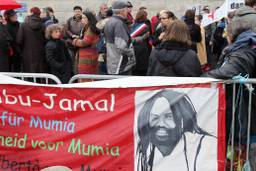Local Occupy protests have spread across the United States, from New York City to the West Coast, from Seattle to Los Angeles and San Francisco (the latest city to see scuffles between protesters and police and allegations of police brutality).
In Philadelphia, an encampment of tents in Dilworth Plaza outside City Hall is holding fast despite the rain, but planned construction work due to start on November 15 may force Occupy Philly to relocate. Meanwhile, the first day of “occupation” in Detroit is planned for this Friday, to coincide with a visit from President Obama.But it’s not just liberal-leaning big city dwellers who are taking to the streets, sidewalks and parks. Occupy groups are also springing up in small towns across the country, despite comments like those made by Covington, KY city commissioner Steve Frank. “Turn out the lights on the Occupiers, I feel like going Taliban on them!” he said in a Facebook post.
A story posted by News 8 in Connecticut about a small gathering in Branford Green, CT drew equally derisive if less threatening comments calling the group “kooks,” communists and “a joke.”Yet 75 people showed up to plan a demonstration starting Saturday in Ashland, KY. Group member Trinity Hurst told Ashland’s The Independent, “We are the people who are supposed to be policing our government.”A group in Martinsburg, WV plans to protest on Saturday to show that people in small communities are fed up too, organizer Jacob Allen told the Herald-Mail. Between 50 and 60 people are expected.A planning session for another Saturday protest in Chapel Hill, NC drew 100 people. Participant Laurel Ashton said to The Daily Tar Heel, “There are national problems apparent in our small town.”
Occupy groups and protests quickly reached outside the continental U.S. to both Alaska and Hawaii, as well as Canada and Mexico, and have now spread across the globe. At the time of writing, the Occupy Together website listed Occupy Together Meetups in 1,407 cities.
The Occupy Wall Street protest is hitting home for Americans from different places, both urban and rural, big and small. Although they may be very different from each other, they’re all a part of the “99 percent.”
And across the Atlantic, Sunday saw an example of how the Occupy idea can adapt itself to specific locations and specific issues without being co-opted by a mainstream group. It was perhaps only fitting that this protest was organized by UK Uncut, the anti-austerity group that can arguably be seen as a precursor (via US Uncut) to Occupy Wall Street.
More than 2,000 people (according to The Guardian) sat down on Westminster Bridge to “Block the Bridge, Block the Bill.” The bill in question is the Health and Social Care Bill, seen by demonstrators as an attempt by the Conservative-Liberal Democrat coalition government to gut the United Kingdom’s National Health Service and more further towards a privatized healthcare system. In other words, a healthcare system move amenable to corporate interests.
Today brought bad news for those protesters: The House of Lords. the U.K.‘s unelected upper house of legislature, passed the bill, and amendments proposed to derail it were defeated. But rather than discouraging British versions of the Occupy movement, expect this to inspire more.
Lisa Klein is a fall 2011 In These Times editorial intern.


